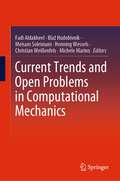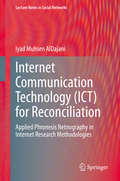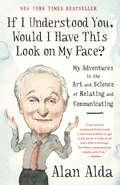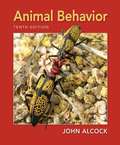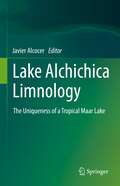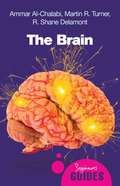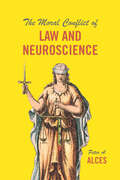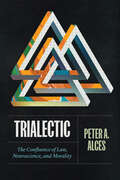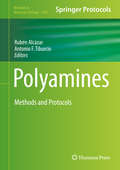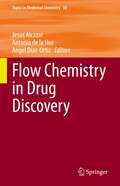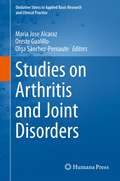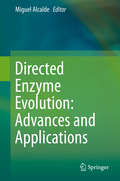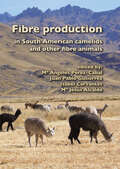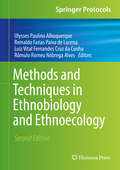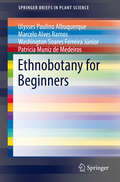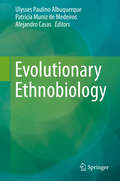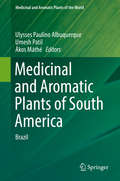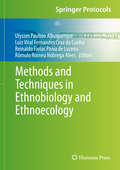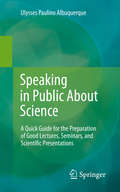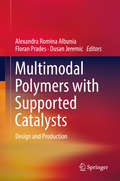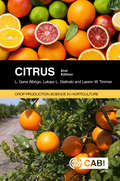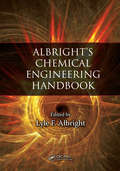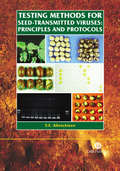- Table View
- List View
Current Trends and Open Problems in Computational Mechanics
by Fadi Aldakheel Blaž Hudobivnik Meisam Soleimani Henning Wessels Christian Weißenfels Michele MarinoThis Festschrift is dedicated to Professor Dr.-Ing. habil. Peter Wriggers on the occasion of his 70th birthday. Thanks to his high dedication to research, over the years Peter Wriggers has built an international network with renowned experts in the field of computational mechanics. This is proven by the large number of contributions from friends and collaborators as well as former PhD students from all over the world. The diversity of Peter Wriggers network is mirrored by the range of topics that are covered by this book. To name only a few, these include contact mechanics, finite & virtual element technologies, micromechanics, multiscale approaches, fracture mechanics, isogeometric analysis, stochastic methods, meshfree and particle methods. Applications of numerical simulation to specific problems, e.g. Biomechanics and Additive Manufacturing is also covered. The volume intends to present an overview of the state of the art and current trends in computational mechanics for academia and industry.
Internet Communication Technology: Applied Phronesis Netnography in Internet Research Methodologies (Lecture Notes in Social Networks)
by Iyad Muhsen AlDajaniThe book explores Applied Phronesis in internet communication technology and Netnography application, introducing it on Facebook and YouTube usages. It defines two pillars for the research dynamics, “Episteme” and “Techne.” – the know-how, how-to, and the power dynamics. The “Episteme” explores the dynamics of reconciliation in the middle of conflict, Internet communication technologies for transformation, Moderation in Islam, online Deliberative Democracy.The second pillar, “Techne,” is explored through Internet communication technology for the advancement of reconciliation in the middle of a conflict.The book describes the Phronetic Approach in internet research in academic discourse adopting Phronesis “an Aristotelian concept and method defined by Bent Flyvbjerg,” and exploring Netnography for Kozinets, in Mixed-Method research design and applying methodological triangulation in research and testing the hypothesis using qualitative content analysis for Krippendorff, developing a methodological discourse for interdisciplinary research using internet communication technologies as part of understanding big-date, introducing Applied Digital Humanities.
If I Understood You, Would I Have This Look on My Face?: My Adventures in the Art and Science of Relating and Communicating
by Alan Alda<P>Alan Alda, the award-winning actor and bestselling author, tells us the fascinating story of his quest to learn how to communicate better, and to teach others to do the same. With his trademark humor and candor, he explores how to develop empathy as the key factor. Alan Alda has been on a decades-long journey to discover new ways to help people communicate and relate to one another more effectively. <P>If I Understood You, Would I Have This Look on My Face? is the warm, witty, and informative chronicle of how Alda found inspiration in everything from cutting-edge science to classic acting methods. His search began when he was host of PBS’s Scientific American Frontiers, where he interviewed thousands of scientists and developed a knack for helping them communicate complex ideas in ways a wide audience could understand—and Alda wondered if those techniques held a clue to better communication for the rest of us. <P>In his wry and wise voice, Alda reflects on moments of miscommunication in his own life, when an absence of understanding resulted in problems both big and small. He guides us through his discoveries, showing how communication can be improved through learning to relate to the other person: listening with our eyes, looking for clues in another’s face, using the power of a compelling story, avoiding jargon, and reading another person so well that you become “in sync” with them, and know what they are thinking and feeling—especially when you’re talking about the hard stuff. <P>Drawing on improvisation training, theater, and storytelling techniques from a life of acting, and with insights from recent scientific studies, Alda describes ways we can build empathy, nurture our innate mind-reading abilities, and improve the way we relate and talk with others. Exploring empathy-boosting games and exercises, If I Understood You is a funny, thought-provoking guide that can be used by all of us, in every aspect of our lives—with our friends, lovers, and families, with our doctors, in business settings, and beyond. <P><b>A New York Times Bestseller</b>
Animal Behavior: An Evolutionary Approach
by John AlcockThe tenth edition features a major reorganisation, focusing first on the evolutionary basis of behavior followed by the underlying proximate mechanisms. Enduring features of previous editions also remain; the clear engaging writing style, the beautifully illustrated text with many new photographs and numerous references to new scientific articles.
Lake Alchichica Limnology: The Uniqueness of a Tropical Maar Lake
by Javier AlcocerThe book provides a comprehensive account of a tropical lake, Alchichica, considering that tropical limnology is by far less known and well-understood than temperate. Many of the well-known temperate limnology paradigms do not apply in tropical limnology, such as the ≥ 1ºC/m thermocline concept, or the role of phosphorous as a limiting nutrient. Lake Alchichica is - most likely – the best limnologically known Mexican lake up to date. Twenty years of continuous monitoring has led us to understand this deep, warm monomictic lake. The peculiar chemical composition of this saline lake – sodium-alkaline with a high concentration in magnesium waters, and groundwater-fed – led to the formation of its unique stromatolite ring that has become world-famous, studied by scientists from various countries. From a biological point of view, this relatively small maar lake displays a comparatively low species richness but surprisingly is plentiful in microendemic species for a recently-formed lake (13,000-6,300 years old, at the Late Pleistocene/Holocene Epoch), eleven of which already described, with more to come. Researchers and students interested in tropical limnology, extreme ecosystems, evolutionary biology, astrobiology, and microbiology will find this book a must-read.
The Brain: A Beginner's Guide (Beginner's Guides)
by Ammar Al-Chalabi Martin R. Turner R. Shane DelamontIt has been remarked that if the brain were so simple we could understand it, we would be so simple we couldn't. Commencing with a brief history of neuroscience, from the ancient practice of drilling holes in the head to relieve headaches to the latest results from MRI and CT scans, this accessible guide sets out to explore exactly what we do know about the brain. Including the most up-to-date research on the cerebral processes behind a wide array of human activity - from our capacity for language to how we remember - this lively and entertaining introduction assumes no previous scientific knowledge and offers a tantalizing glimpse into man's most complex organ. Ammar Al-Chalabi is Honourary Consultant Neurologist at King's College Hospital, and a Senior Lecturer at the Institute of Psychiatry, London. R. Shane Delamont is a Consultant Neurologist at King's College Hospital, and Martin Turner is Wellcome Fellow in Neurology at The Institute of Psychiatry. All three have extensive experience of teaching the key principles of neuroscience, and between them their specialist fields of expertise cover all of the main areas of contemporary brain research.
The Moral Conflict of Law and Neuroscience
by Peter A. AlcesLaw relies on a conception of human agency, the idea that humans are capable of making their own choices and are morally responsible for the consequences. But what if that is not the case? Over the past half century, the story of the law has been one of increased acuity concerning the human condition, especially the workings of the brain. The law already considers select cognitive realities in evaluating questions of agency and responsibility, such as age, sanity, and emotional distress. As new neuroscientific research comprehensively calls into question the very idea of free will, how should the law respond to this revised understanding? Peter A. Alces considers where and how the law currently fails to appreciate the neuroscientific revelation that humans may in key ways lack normative free will—and therefore moral responsibility. The most accessible setting in which to consider the potential impact of neuroscience is criminal law, as certain aspects of criminal law already reveal the naiveté of most normative reasoning, such as the inconsistent treatment of people with equally disadvantageous cognitive deficits, whether congenital or acquired. But tort and contract law also assume a flawed conception of human agency and responsibility. Alces reveals the internal contradictions of extant legal doctrine and concludes by considering what would be involved in constructing novel legal regimes based on emerging neuroscientific insights.
Trialectic: The Confluence of Law, Neuroscience, and Morality
by Peter A. AlcesA thought-provoking examination of how insights from neuroscience challenge deeply held assumptions about morality and law. As emerging neuroscientific insights change our understanding of what it means to be human, the law must grapple with monumental questions, both metaphysical and practical. Recent advances pose significant philosophical challenges: how do neuroscientific revelations redefine our conception of morality, and how should the law adjust accordingly? Trialectic takes account of those advances, arguing that they will challenge normative theory most profoundly. If all sentient beings are the coincidence of mechanical forces, as science suggests, then it follows that the time has come to reevaluate laws grounded in theories dependent on the immaterial that distinguish the mental and emotional from the physical. Legal expert Peter A. Alces contends that such theories are misguided—so misguided that they undermine law and, ultimately, human thriving. Building on the foundation outlined in his previous work, The Moral Conflict of Law and Neuroscience, Alces further investigates the implications for legal doctrine and practice.
Polyamines: Methods and Protocols (Methods in Molecular Biology #1694)
by Rubén Alcázar Antonio F. TiburcioThis volume provides readers with a collection of the latest protocols used by researchers to study polyamines (PA). The chapters in this book cover various topics, such as quantification of different polyamines and conjugates, subcellular localization studies, transport, DNA methylation, ODC regulation, genetic and phenotyping analyses, genome-wide association mapping, polyamine applications and cancer. Written in the highly successful Methods in Molecular Biology series format, chapters include introductions to their respective topics, lists of the necessary materials and reagents, step-by-step, readily reproducible laboratory protocols, and tips on troubleshooting and avoiding known pitfalls. Comprehensive and cutting-edge, Polyamines: Methods and Protocols is a useful reference for researchers looking to advance and stimulate their knowledge of polyamines.
Flow Chemistry in Drug Discovery (Topics in Medicinal Chemistry #38)
by Jesus Alcazar Antonio de la Hoz Angel Díaz-OrtizThis book reviews the challenges and opportunities posed by flow chemistry in drug discovery, and offers a handy reference tool for medicinal chemists interested in the synthesis of biologically active compounds. Prepared by expert contributors, the respective chapters cover not only fundamental methodologies and reactions, such as the application of catalysis, especially biocatalysis and organocatalysis; and non-conventional activation techniques, from photochemistry to electrochemistry; but also the development of new process windows, processes and reactions in drug synthesis. Particular attention is given to automatization and library synthesis, which are of great importance in the pharmaceutical industry. Readers will also find coverage on selected topics of general interest, such as how flow chemistry is contributing to drug discovery R&D in developing countries, and the green character of this enabling technology, for example in the production of raw materials for the pharmaceutical industry from waste. Given its scope, the book appeals to medicinal chemistry researchers working in academia and industry alike, as well as professionals involved in scale-up and drug development.
Studies on Arthritis and Joint Disorders
by Maria Jose Alcaraz Olga Sánchez-Pernaute Oreste GualilloThis next volume in our established series proposes to systematically review the basic science and clinical knowledge of the role of free radicals and antioxidants, collectively known as "oxidative stress", in the pathology of arthritis and other joint diseases. It will describe the most current diagnostic tools , laboratory methods and technology, to suggest ways of prevention and treatment and to emphasize the concept of the bench-to-bedside approach. The book will also provide specific coverage on emerging technology and medical applications including discussions of biomarkers and antioxidants as therapeutic agents and several more relevant aspects. In addition, the book will promote the concept of using biomarkers representative of oxidative stress reactions and free radical damage , as well as describe the effect of antioxidants in treating disease in clinical trials. The content will be valuable to researchers studying the development of arthritis/joint disease, and clinicians treating patients with these diagnoses.
Directed Enzyme Evolution: Advances and Applications
by Miguel AlcaldeThis book focuses on some of the most significant advances in enzyme engineering that have been achieved through directed evolution and hybrid approaches. On the 25th anniversary of the discovery of directed evolution, this volume is a tribute to the pioneers of this thrilling research field, and at the same time provides a comprehensive overview of current research and the state of the art. Directed molecular evolution has become the most reliable and robust method to tailor enzymes, metabolic pathways or even whole microorganisms with improved traits. By mirroring the Darwinian algorithm of natural selection on a laboratory scale, new biomolecules of invaluable biotechnological interest can now be engineered in a manner that surpasses the boundaries of nature. The volume is divided into two sections, the first of which provides an update on recent successful cases of enzyme ensembles from different areas of the biotechnological spectrum, including tryptophan synthases, unspecific peroxygenases, phytases, therapeutic enzymes, stereoselective enzymes and CO2-fixing enzymes. This section also provides information on the directed evolution of whole cells. The second section of the book summarizes a variety of the most applicable methods for library creation, together with the future trends aimed at bringing together directed evolution and in silico/computational enzyme design and ancestral resurrection.
Fibre production in South American camelids and other fibre animals
by Maria Jesús Alcalde Maria Ángeles Pérez-Cabal Isabel Cervantes Juan Pablo GutiérrezThis book, 'Fibre production in South American camelids and other fibre animals', covers the latest advances in the main fields of animals producing fibre. It deals with a wide scope of fibre animals and a great variety of subjects and is supported by the Animal Fibre Working Group belonging to the European Association of Animal Production. The book can be considered a valuable attempt to prepare the fibre production sector for rapid changes and innovations arising within a globalised world. The focus lies on fibre animals such as alpacas, llamas, vicunas and guanacos, but recent research on sheep, goats and rabbits is also included. The most important themes addressed are meat and fibre production, breeding and genetics, nutrition, reproduction, management, and health. Finally, the book closes with specialised discussions on fibre production related topics, which for example provide a more in-depth look at common management denominators between South American camelids and other fibre animals. The book addresses scientists, professionals, technicians, farmers, specialised governmental policy makers and students all around the world who are involved in fibre animal production (such as sheep, camelids, goats, or rabbits). This book will present them with the most current findings in this area.
Methods and Techniques in Ethnobiology and Ethnoecology (Springer Protocols Handbooks)
by Ulysses Paulino Albuquerque Reinaldo Farias de Lucena Luiz Vital Cruz da Cunha Rômulo Romeu AlvesEthnobiology and ethnoecology have become very popular in recent years. Particularly in the last 20 years, many manuals of methods have published the most classical approaches to the subject. There have been, however, many advances in research as a result of interaction with different disciplines, but also due to more recent results, new original and interesting questions.This handbook provides the current state of the art methods and techniques in ethnobiology and ethnoecology, and related fields. This new volume, besides bringing new and original aspects of what is found in the literature, fills some of the gaps in volume one by including the most systematic and extensive treatment of methods and techniques in qualitative research. Along with the various methods covered in the individual chapters, the handbook also includes an extensive bibliography that details the current literature in the field.
Ethnobotany for Beginners
by Ulysses Paulino Albuquerque Marcelo Alves Ramos Washington Soares Ferreira Júnior Patrícia Muniz De MedeirosDesigned for new scholars, this book features a quick and easy-to-read discussion of ethnobotany along with its major developments. The language is clear and concise, objective and straightforward, and structured to lead the reader from the beginning of this science to the most recent developments. While there are some books on ethnobotany, mainly dealing with methods, this book covers the topic in an introductory and comprehensive text that prepares the reader for more advanced study of ethnobotany.
Evolutionary Ethnobiology
by Ulysses Paulino Albuquerque Patrícia Muniz De Medeiros Alejandro CasasEthnobiology is a fascinating science. To understand this vocation it needs to be studied under an evolutionary point of view that is very strong and significant, although this aspect is often poorly approached in the literature. This is the first book to compile and discuss information about evolutionary ethnobiology in English.
Medicinal and Aromatic Plants of South America: Brazil (Medicinal and Aromatic Plants of the World #5)
by Ulysses Paulino Albuquerque Umesh Patil Ákos MáthéThis volume in the series deals with the major Medicinal and Aromatic Plants (MAPs) of South America, providing information on major aspects of this specific group of plants on that continent (botany, traditional usage, chemistry, production/collection practices, trade and utilization). Brazil, in particular, offers an immense amount of biodiversity, including plants with great pharmacological interest and ethno-medicinal importance. Contributions are from internationally recognized professionals, specialists of the Medicinal and Aromatic Plant domain and have been invited mostly from the members of the International Society for Horticultural Science and International Council for Medicinal and Aromatic Plants.
Methods and Techniques in Ethnobiology and Ethnoecology
by Ulysses Paulino Albuquerque Luiz Vital Fernandes Cruz Cunha Reinaldo Farias Paiva Lucena Rômulo Romeu Nóbrega AlvesHumans represent just one of many species that constitute the planet's biodiversity. Nevertheless, as the dominant species, humans have been the primary agent of the transformation of natural spaces. Therefore, the study of human interactions, biodiversity, and the environment that surrounds them is a basic tool for understanding the factors that bind human societies to natural resources. Within this context, ethnobiology is a promising discipline that can play a key role as a mediator of dialogue between different academic disciplines and traditional knowledge, a union essential in enabling contextualized and sustainable alternatives to exploitative practices and biodiversity management. "Methods and Techniques in Ethnobiology and Ethnoecology" introduces the basic techniques and methods traditionally used in ethnobiology and ethnoecology. Comprised of 28 chapters, the book covers the different qualitative and quantitative aspects of ethnobiology research methods, as well as methods from natural and social sciences that will be useful to both beginners and senior researchers. Written by internationally renowned experts in the fields, "Methods and Techniques in Ethnobiology and Ethnoecology "is a valuable resource for researchers and students interested in ethnobiology.
Speaking in Public About Science
by Ulysses Paulino AlbuquerqueThis book introduces the basic techniques and methods traditionally used in speaking about science to the public. The public often has a very different perception and understanding of science, and this must be taken into account when communicating with the public. This volume covers methods of scientific discourse, oral communication, preparation of the presentation, techniques and use of visual resources, and exercises for perfecting the technique of speaking in public about science. Speaking in Public About Science: A Quick Guide for the Preparation of Good Lectures, Seminars, and Scientific Presentations is a concise yet comprehensive resource that will be of value to beginners and senior scholars and researchers.
Quantum Chemistry Simulation of Biological Molecules
by Eudenilson L. Albuquerque Umberto L. Fulco Ewerton W. Caetano Valder N. FreireNano-biotechnology crosses the boundaries between physics, biochemistry and bioengineering, and has profound implications for the biomedical engineering industry. This book describes the quantum chemical simulation of a wide variety of molecular systems, with detailed analysis of their quantum chemical properties, individual molecular configurations, and cutting-edge biomedical applications. Topics covered include the basic properties of quantum chemistry and its conceptual foundations, the nanoelectronics and thermodynamics of DNA, the optoelectronic properties of the five DNA/RNA nucleobase anhydrous crystals, and key examples of molecular diode prototypes. A wide range of important applications are described, including protein binding of drugs such as cholesterol-lowering, anti-Parkinson and anti-migraine drugs, and recent developments in cancer biology are also discussed. This modern and comprehensive text is essential reading for graduate students and researchers in multidisciplinary areas of biological physics, chemical physics, chemical engineering, biochemistry and bioengineering.
Quantum Codes for Topological Quantum Computation (SpringerBriefs in Mathematics)
by Clarice Dias Albuquerque Eduardo Brandani Silva Waldir Silva Soares Jr.This book offers a structured algebraic and geometric approach to the classification and construction of quantum codes for topological quantum computation. It combines key concepts in linear algebra, algebraic topology, hyperbolic geometry, group theory, quantum mechanics, and classical and quantum coding theory to help readers understand and develop quantum codes for topological quantum computation.One possible approach to building a quantum computer is based on surface codes, operated as stabilizer codes. The surface codes evolved from Kitaev's toric codes, as a means to developing models for topological order by using qubits distributed on the surface of a toroid. A significant advantage of surface codes is their relative tolerance to local errors. A second approach is based on color codes, which are topological stabilizer codes defined on a tessellation with geometrically local stabilizer generators. This book provides basic geometric concepts, like surface geometry, hyperbolic geometry and tessellation, as well as basic algebraic concepts, like stabilizer formalism, for the construction of the most promising classes of quantum error-correcting codes such as surfaces codes and color codes.The book is intended for senior undergraduate and graduate students in Electrical Engineering and Mathematics with an understanding of the basic concepts of linear algebra and quantum mechanics.
Multimodal Polymers with Supported Catalysts: Design And Production
by Alexandra Romina Albunia Floran Prades Dusan JeremicThis book provides an overview of polyolefine production, including several recent breakthrough innovations in the fields of catalysis, process technology, and materials design. The industrial development of polymers is an extraordinary example of multidisciplinary cooperation, involving experts from different fields. An understanding of structure-property and processing relationships leads to the design of materials with innovative performance profiles. A comprehensive description of the connection between innovative material performance and multimodal polymer design, which incorporates both flexibility and constraints of multimodal processes and catalyst needs, is provided. This book provides a summary of the polymerization process, from the atomistic level to the macroscale, process components, including catalysts, and their influence on final polymer performance. This reference merges academic research and industrial knowledge to fill the gaps between academic research and industrial processes.
Citrus (Crop Production Science In Horticulture Ser.)
by L. Gene Albrigo Dr Lukasz L. Stelinski Lavern TimmerCitrus fruit, originating in Southeast Asia, have been cultivated and enjoyed for over 4000 years. Moreover, they are grown in nearly every country within 40°north-south latitude, the major producers being China, Brazil, the USA, and countries bordering the Mediterranean. This new edition continues to adopt an international perspective on citrus, covering its biology and cultivation as well as considering issues in the citrus industry and providing examples from around the world. The authors include discussion on important topics such as biotechnical advances in citrus genetics, current techniques in breeding, the role of climatic factors in worldwide production, the importance of rootstocks, plant husbandry, pests and diseases, and postharvest technology. They emphasize current theories and technological advances in citriculture, citing specific examples of how they are used and in which regions. Citrus 2nd edition describes the scientific basis of production practices and is aimed at professionals in the industry as well as advanced students of horticulture and allied disciplines within plant science and food science.
Albright's Chemical Engineering Handbook
by Lyle F. AlbrightTaking greater advantage of powerful computing capabilities over the last several years, the development of fundamental information and new models has led to major advances in nearly every aspect of chemical engineering. Albright's Chemical Engineering Handbook represents a reliable source of updated methods, applications, and fundamental co
Testing Methods for Seed-transmitted Viruses: Principles and Protocols
by S. E. AlbrechtsenThis practical guide covers the commonly used detection methods for seed-transmitted viruses and viroids that affect both tropical and temperate crops. It contains 25 complete step-by-step procedures for biological, serological and molecular techniques to detect and identify such viruses. Combining helpful practical notes with more detailed explanations of the principles behind the techniques, the book describes the general characteristics of seed-transmitted viral diseases and discusses outlines for the organization and interpretation of seed health assays. The techniques reviewed are also applicable to non-seed-transmitted viral agents.
